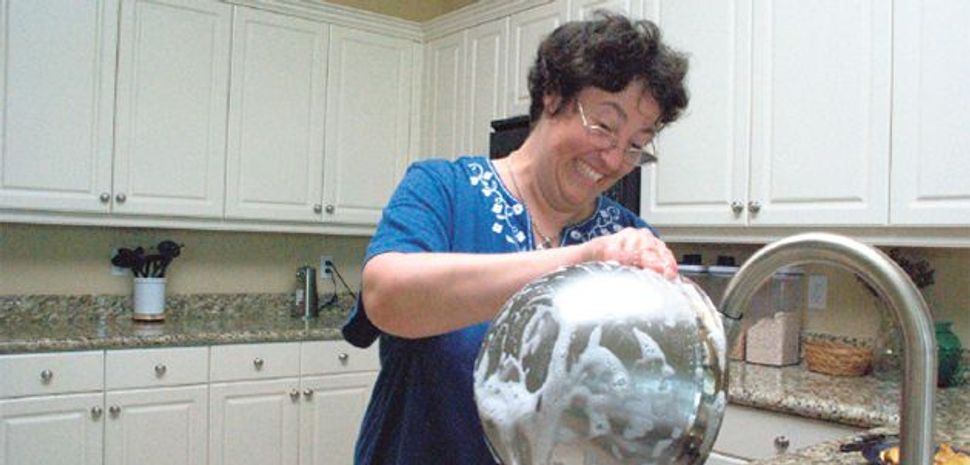To Care for Disabled Kids and Young Adults, Parents Increasingly Turn to Group Homes

Group Home: A resident of JARC tends to her group home for disabled adults in Boca Raton. Image by Courtesy of JARC
Soon after Scott Goldenberg’s birth, his parents began thinking about something that rarely preoccupies the parents of a newborn: What happens to him when we’re gone?
Their infant son had survived meningitis, only to be left with multiple physical and intellectual problems: cerebral palsy, learning disabilities, limited vision and walking difficulties. When Joe and Zeena Goldenberg tried to enroll Scott in public school, they were told, “We’ve had kids with all these things, but not all in one child.” It was a condition requiring special placement.
The Goldenbergs — he, a pediatrician; she, a special education teacher — were especially well equipped to hurdle the roadblocks presented by their son’s needs. They began saving for his future. They sought out every available resource in the Creve Coeur, Mo., area, and beyond. They found a private school eager to have him, and a Jewish special-needs camp in Canada, where Scott thrived. And three years ago, when their son was 22, they found a small group home at the private, not-for-profit Jewish Association for Residential Care here in Boca Raton, where he has made friends and enrolled in a work-skills class for mailroom or assembly jobs.
“We would love to keep him at home, but there is no peer group for him, and he was so isolated,” Zeena Goldenberg said. “He was a different kid when he was home; he would get frustrated and bored.”
In making Goldenberg’s placement, his parents benefited from enlightened laws and an altered social landscape that emphasized inclusion and belonging over separation. The Individuals with Disabilities Education Act, enacted in 1990 and reauthorized in 1997, mandated that all children are entitled to an education both free of charge and “appropriate,” and that disabled children should receive a publicly funded education from ages 3 to 22. The act was essentially a revision of the Education for All Handicapped Children Act, which, among other things, required school districts to establish a procedure allowing parents of handicapped children to dispute decisions involving their children’s education.
Those rulings resulted in better-informed and more highly involved parents who shared their experiences with one another and became fierce advocates for their children’s rights and planners for their futures. For the children, it has meant lives lived in a community rather than at an institution.
Nowadays, said Dr. Debra Hallow, executive director of JARC, “Parents are making plans earlier because they understand that part of their responsibility is to make those plans, and to make those plans before it is too late and there is a crisis.”
Hallow has seen more than a few parents whose devotion to caring for their disabled children leaves them in crisis in the end. The most vivid cases include an elderly mother who, she recalled, “always said, ‘I’m not ready, I’m not ready, I’m not ready,’” then died before making plans for her middle-aged developmentally disabled son. The task of doing so fell into the lap of the man’s unprepared and frantic sister.
In another case, Hallow recalled, a developmentally disabled man was found living alone — his electricity shut off for lack of payment, his refrigerator empty for lack of transportation to the grocery store — after the death of his father, whose apartment he had shared.
Although some parents still postpone decision-making into their 70s or 80s — the majority of people with developmental disabilities live with family caregivers — many, like the Goldenbergs, are taking action much earlier, in their 40s and 50s. The trend has occurred gradually and without fanfare. For Jewish agencies, Hallow said, the change is most visible in such areas as South Florida and New York, with large Jewish populations.
Paramount among the factors governing this shift is financing.
The money used to pay for placements is usually a mix of federal and state dollars. But the funding difficulties of states that have long been tightly pressed to balance their budgets has only grown worse since the country’s economic plunge has cut deeply into their revenues. A 2008 report on the State of the States in Developmental Disabilities, produced by the Coleman Institute for Cognitive Disabilities at the University of Colorado, noted that “the nation’s overall residential system capacity has doubled since 1987, with an annual growth rate of 5% per year.”
Despite this, there is a growing imbalance between need and availability that has helped to fuel the trend of parents seeking earlier placements. “[Many parents] are alarmed at what might not be available for their child when they are older,” wrote Derek Saker, director of communications for OHEL Children’s Home and Family Services, in Brooklyn, in an e-mail to the Forward.
JARC has seen the trend toward early placements emerge over time. When its first group home opened in Boca Raton in 1987, the residents were mostly middle-aged and older, typical for that period. By the time a fourth home opened, a decade later, the picture had altered dramatically, with most residents in their 20s and early 30s.
“The older generation [of parents] had no network,” Hallow said. “They were caregivers in isolation. Parents are better educated now. They realize that transition needs to take place when they’re young enough to be involved. Also, they don’t want to put that responsibility on their other children.”
Sparing Scott’s older sister, Beth, that responsibility was important to the Goldenbergs. Now a graduate student at New York University, preparing for a career as a costume designer, she can be her brother’s guardian without the day-to-day responsibilities, and she can be assured that he is content and living a satisfying life. Goldenberg and his three housemates each have a room in a handsome Florida-style house with a red barrel-tile roof, a brick patio overlooking a lake, a lighted walking path and a super-sized kosher kitchen area.
“So far, I haven’t found any food he doesn’t like,” house manager Deborah English said, smiling, just minutes before Zeena Goldenberg brought her son home after a weeklong family visit. And yes, Scott said, he was glad to leave the snow behind in Missouri.
The cost of residential care like Goldenberg’s can vary greatly, depending on where a person lives. Most New York programs are fully funded, thanks to the state’s income tax.
On the other hand, Vivian Bass, CEO of the Rockville, Md.-based Jewish Foundation for Group Homes, which serves the greater Washington area, said that the combination of local, state and federal funding received by all but a handful of her agency’s 105 residents does not come close to covering the actual cost of supporting an individual. Maryland, she noted, is among the nation’s most socially progressive states in long-term care for the developmentally disabled, mandating that newly opened homes are limited to a maximum of three unrelated adults. This is a less institutional setting that more closely resembles the living arrangements of those without disabilities. The challenge ahead, she says, is dwindling government resources.
At JARC, in no-income-tax Florida, families pay about $40,000 a year, although need-based scholarships are available for those who qualify, and government-entitlement programs, such as Supplemental Security Income, can defray some of the expense.
At some point, though, Hallow noted, “we will become the family of record because there will be no family. As Jews, we know the last mitzvah you can give people is a good death. I tell people that if we do our job right, people live with us and they die with us.”
Contact Mary Jane Fine at [email protected]














